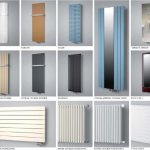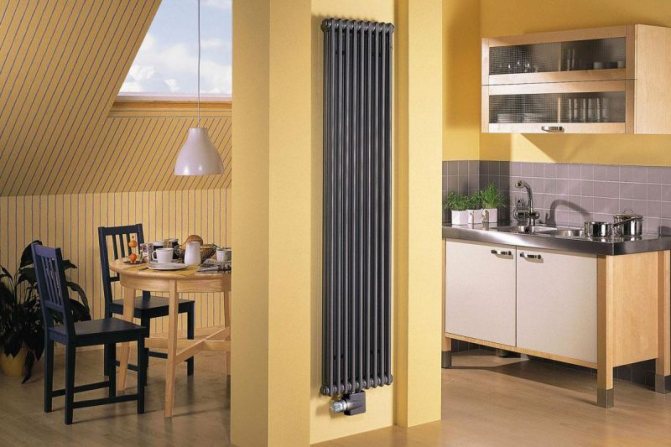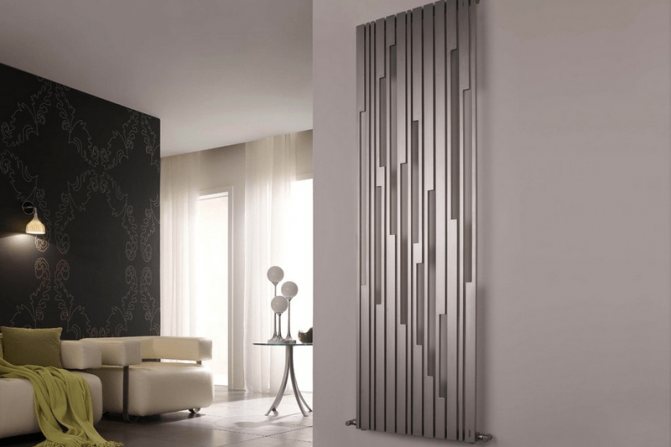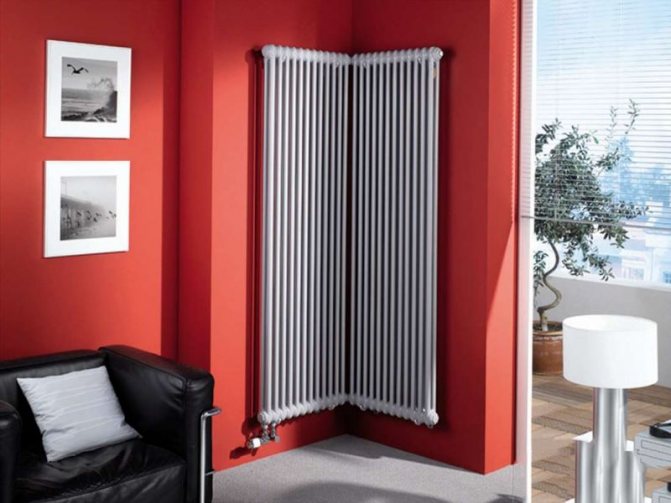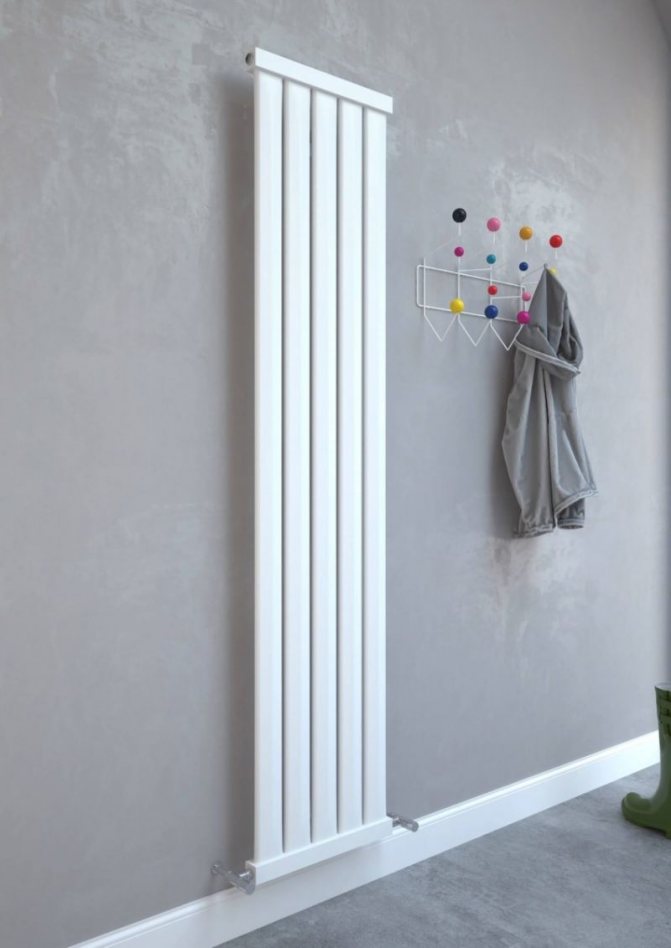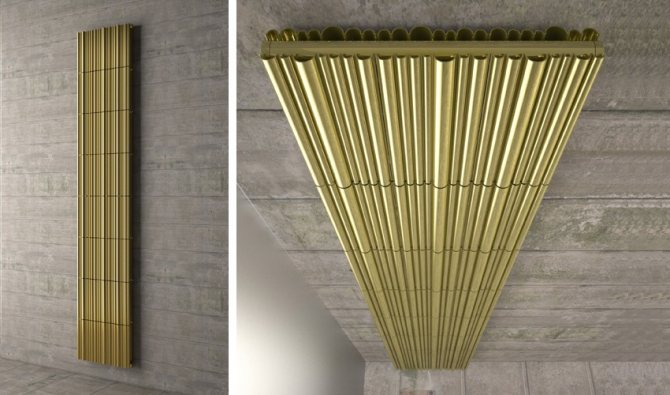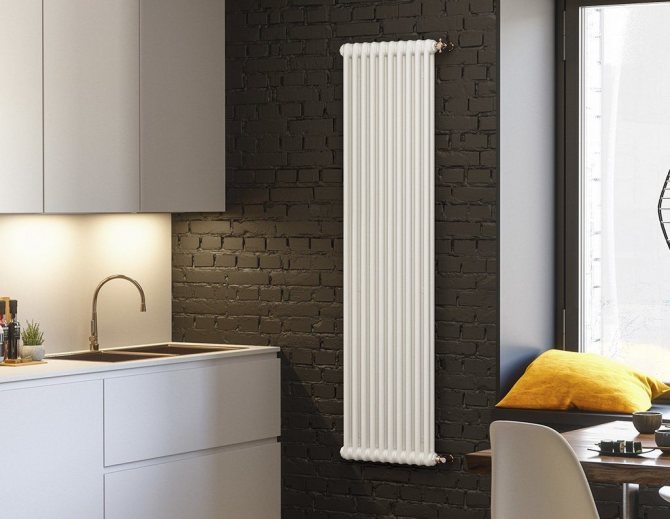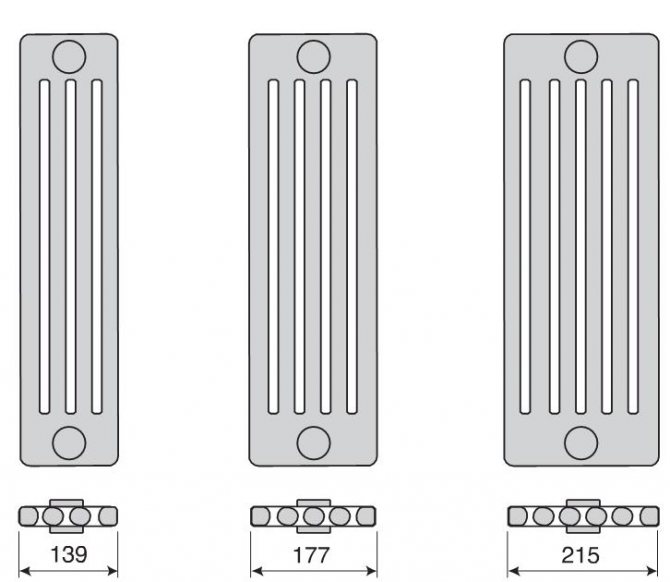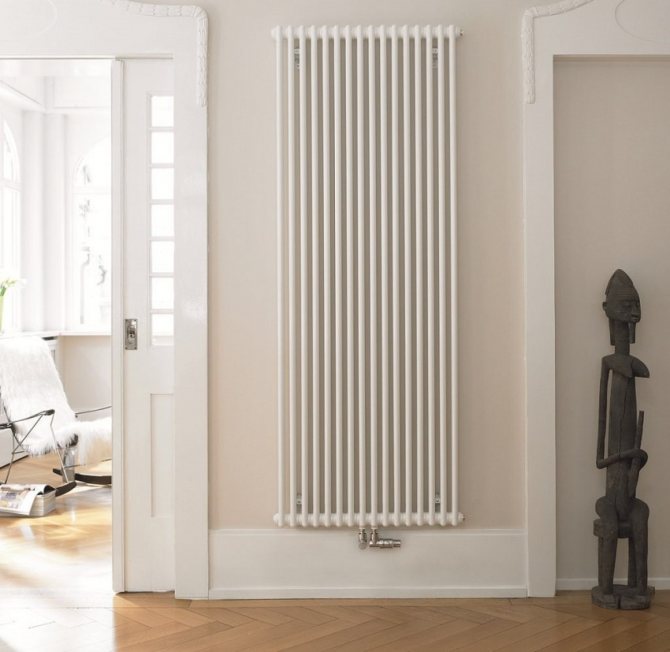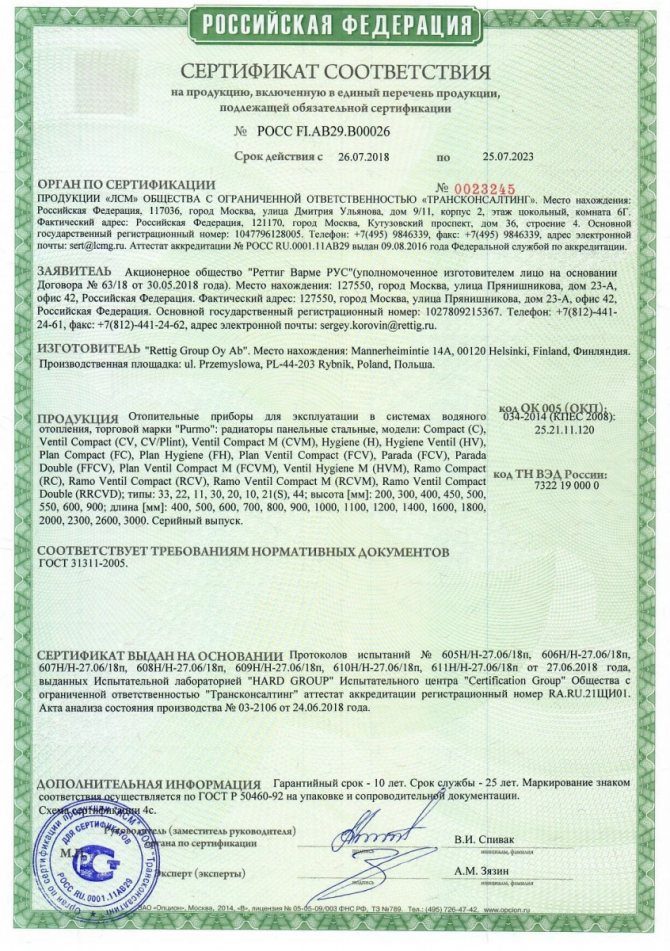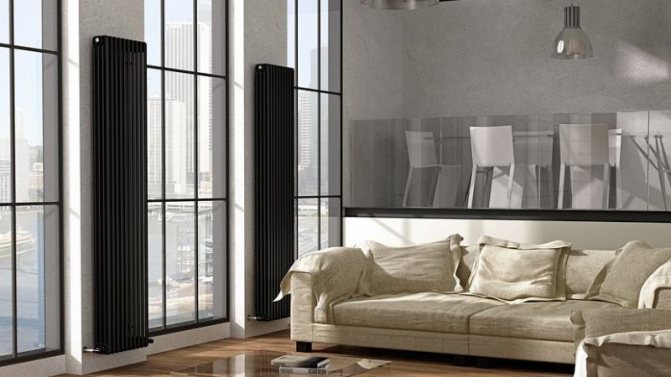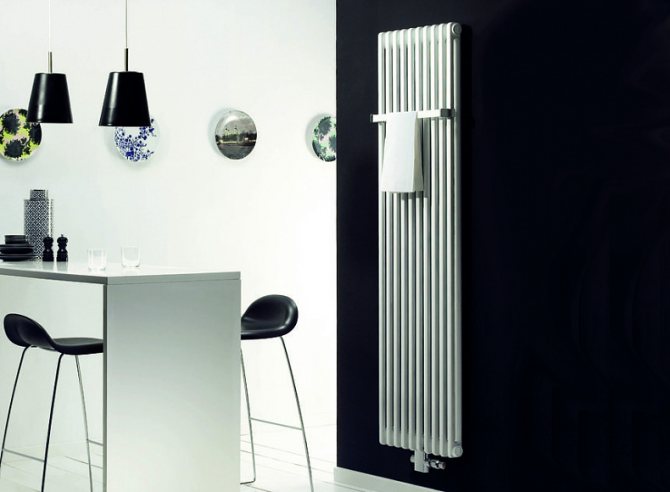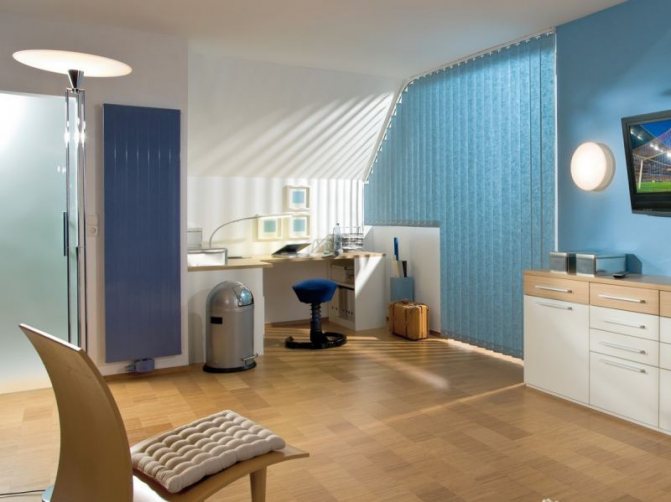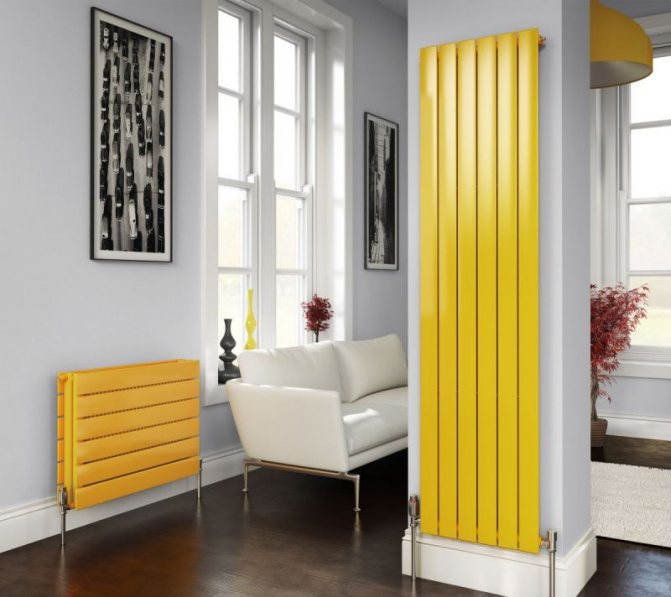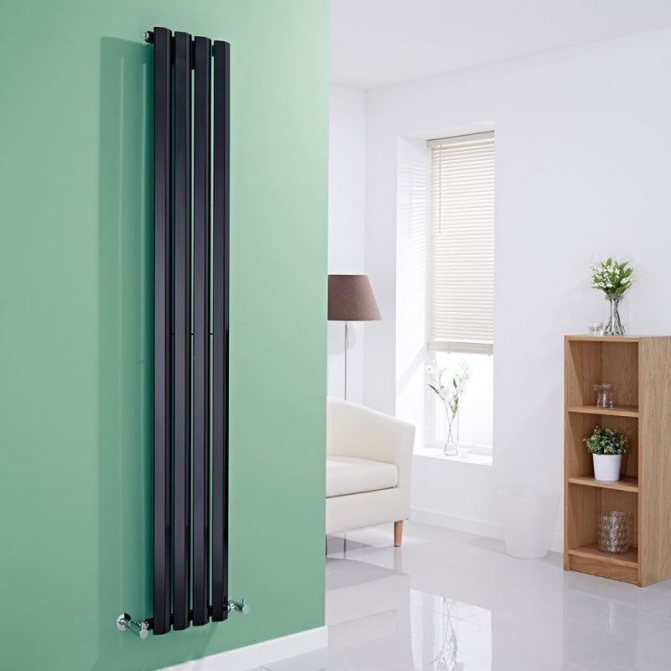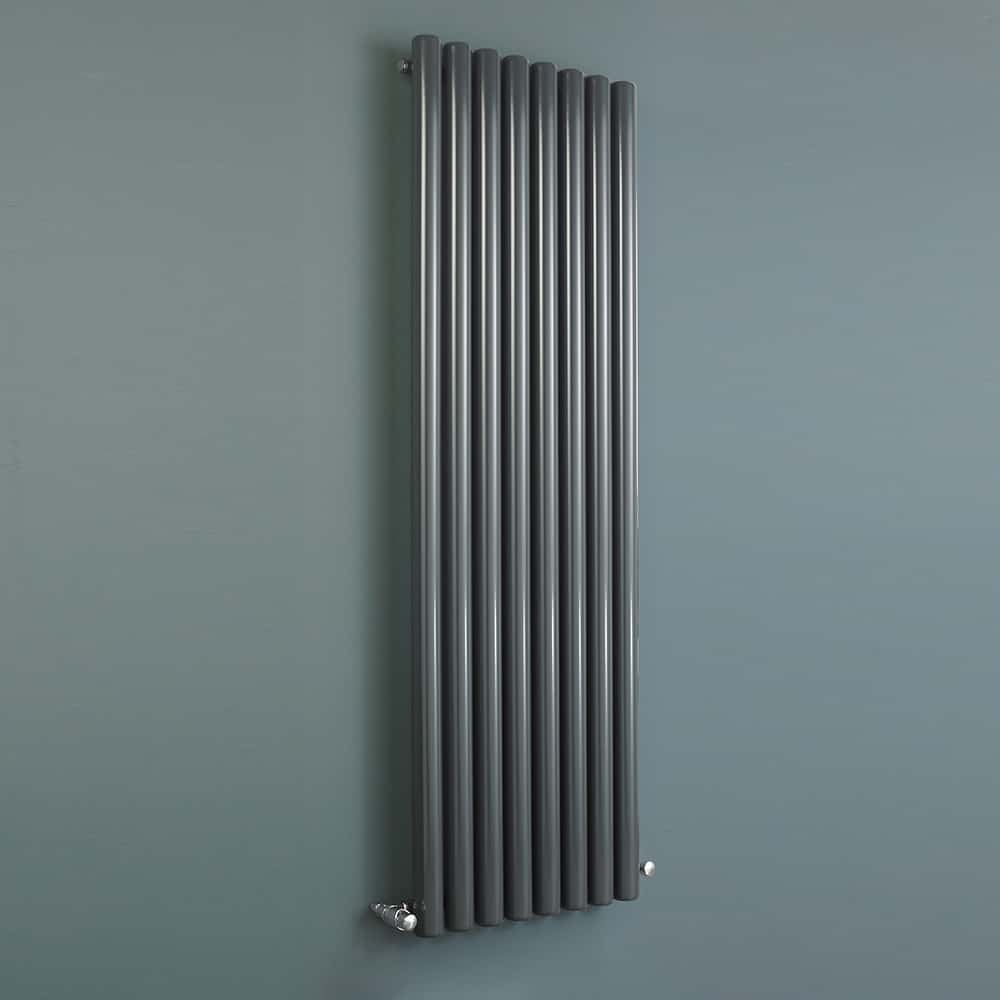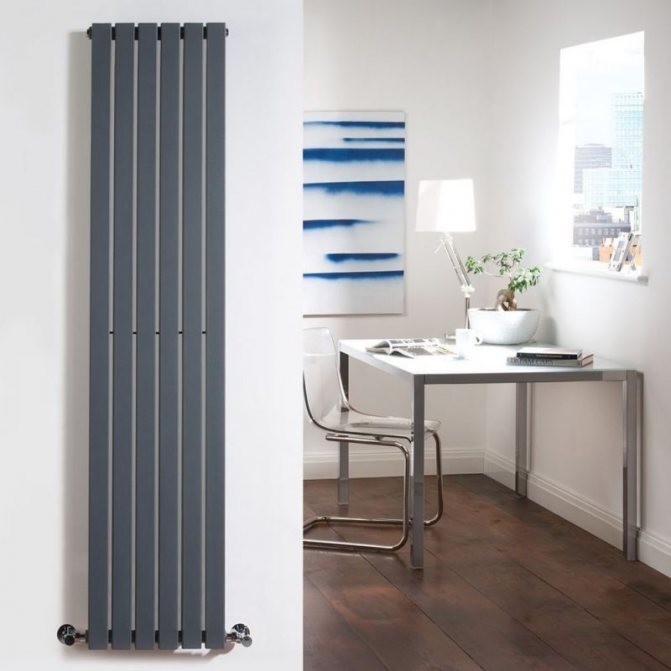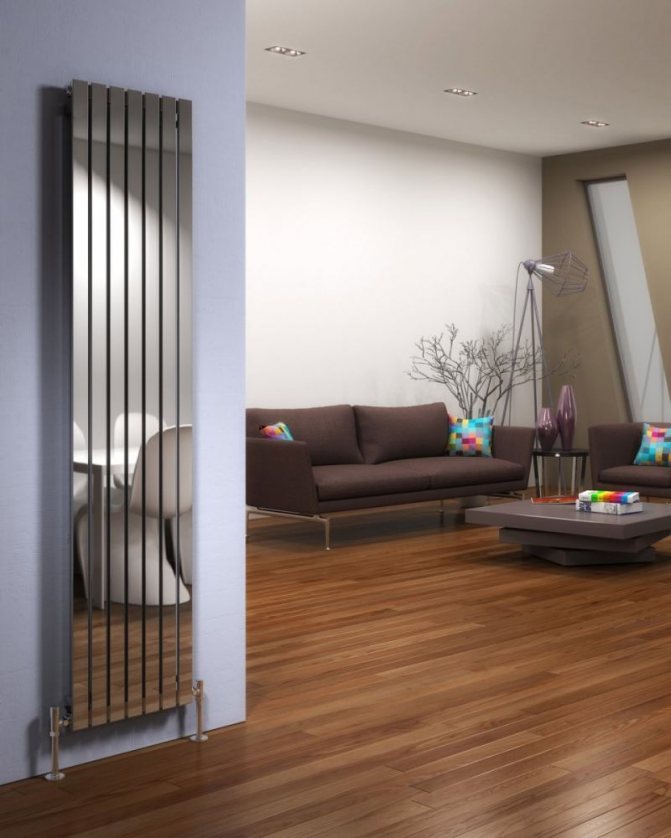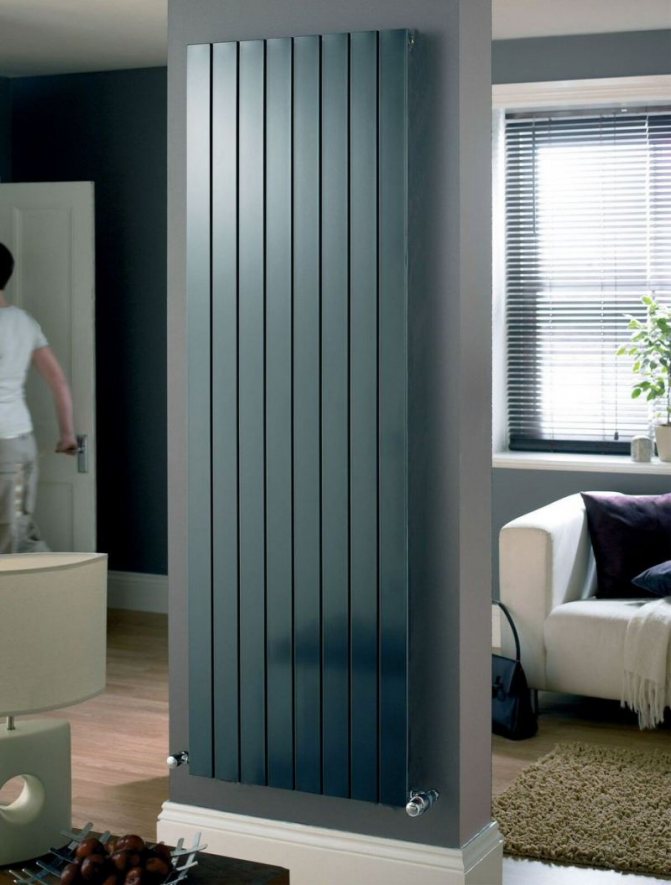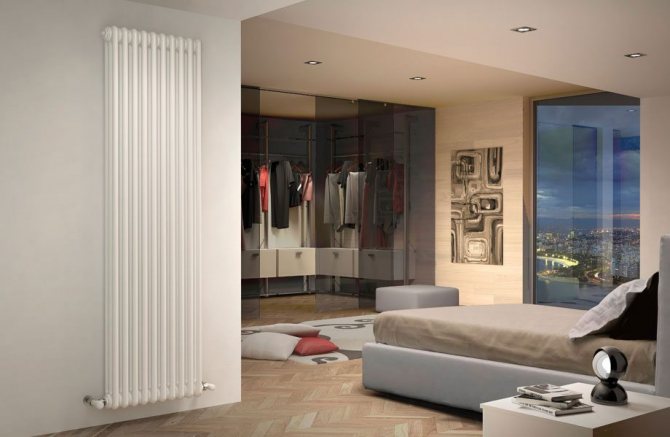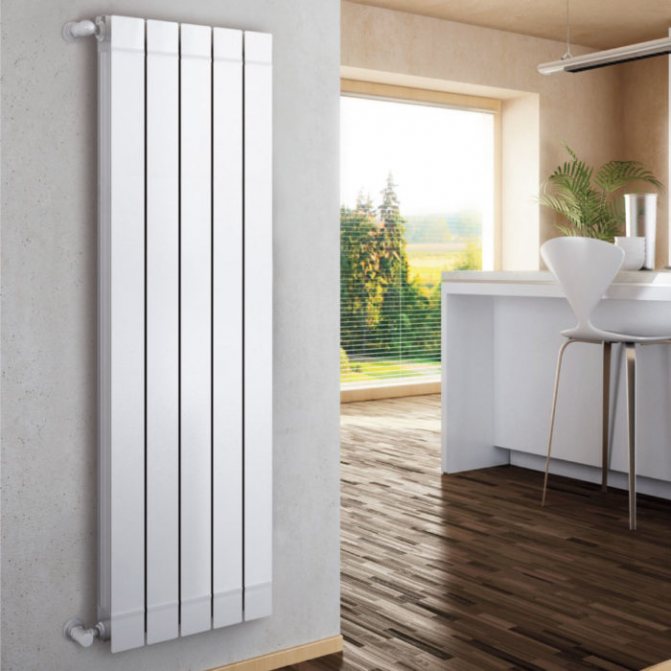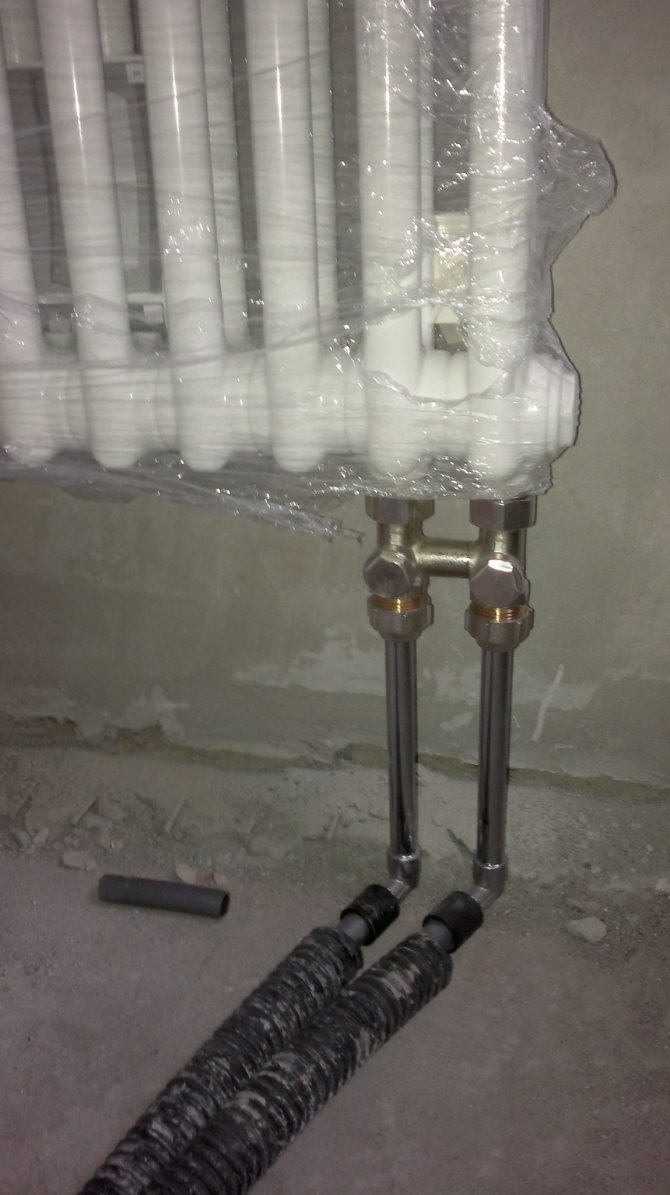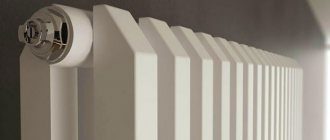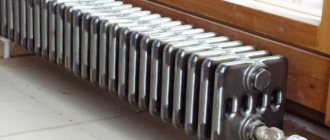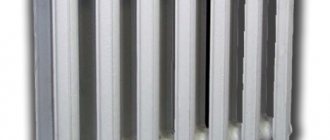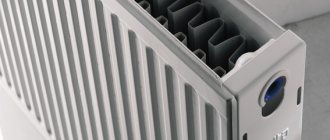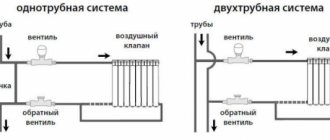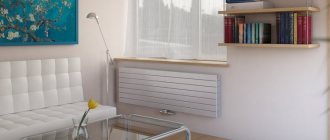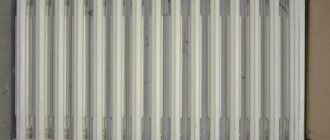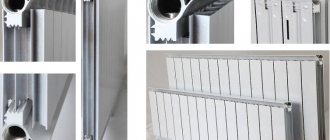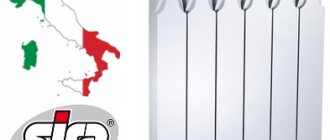Varieties of vertical radiators
The main difference between vertical radiators is their height, which is several times higher than standard options. This design feature allows the heater to be installed in narrow wall spaces. For example, between the openings of panoramic windows.
High heating radiators are distinguished by the material of manufacture, according to which the following models are distinguished:
- • steel • bimetallic • aluminum • convector type
In addition, all vertical radiators differ in their design. In appearance, they are divided into sectional, tubular and panel. Tubular models belong to the classic version, which cannot be said about sectional and panel ones, presented in an unusual design. It is among them that you can find devices that will be a real interior decoration.
Arbonia vertical radiators available on request
High radiators Arbonia in the following standard sizes, with side or bottom connection, in any color of your choice - are available on request. The prices in the table are for radiators in white.
| Model | Section parameters, mm | Possible number of sections | Width range, mm | Heat transfer section | PRICE (per section with side connection) | |||
| height | depth | |||||||
| ∆Т 50K, 75/65/20 ° С | ∆Т 70K, 90/70/20 ° С | |||||||
| Arbonia 2100 | 1000 | 65 | 4-40 | 180 — 1800 | 74 watts | 93 Watt | 893 r | |
| Arbonia 2110 | 1100 | 65 | 4-30 | 180 — 1350 | 81 watts | 102 watts | RUB 926 | |
| Arbonia 2120 | 1200 | 65 | 4-30 | 180 — 1350 | 88 watts | 111 watts | 1000 RUB | |
| Arbonia 2150 | 1500 | 65 | 4-30 | 180 — 1350 | 109 watts | 138 watts | 1265 RUB | |
| Arbonia 2180 | 1800 | 65 | 4-30 | 180 — 1350 | 130 watts | 164 watts | RUB 1,500 | |
| Arbonia 2200 | 2000 | 65 | 4-30 | 180 — 1350 | 144 watts | 182 watts | RUB 1705 | |
| Arbonia 2220 | 2200 | 65 | 4-20 | 180 — 900 | 158 Wt | 199 watts | 1870 RUB | |
| Arbonia 2250 | 2500 | 65 | 4-20 | 180 — 900 | 179 watts | 226 Wt | 2095 RUB | |
| Arbonia 2280 | 2800 | 65 | 4-20 | 180 — 900 | 200 watts | 253 Wt | 2400 RUB | |
| Arbonia 2300 | 3000 | 65 | 4-20 | 180 — 900 | 214 watts | 271 watts | RUB 2,600 | |
| Arbonia 3100 | 1000 | 105 | 4-40 | 180 — 1800 | 102 watts | 130 watts | 1064 RUB | |
| Arbonia 3110 | 1100 | 105 | 4-30 | 180 — 1350 | 111 watts | 141 watts | 1202 RUB | |
| Arbonia 3120 | 1200 | 105 | 4-30 | 180 — 1350 | 120 watts | 152 watts | 1405 RUB | |
| Arbonia 3150 | 1500 | 105 | 4-30 | 180 — 1350 | 147 watts | 187 watts | RUB 1811 | |
| Arbonia 3180 | 1800 | 105 | 4-30 | 180 — 1350 | 173 watts | 219 watts | 2230 RUB | |
| Arbonia 3200 | 2000 | 105 | 4-30 | 180 — 1350 | 190 watts | 241 watts | 2437 RUB | |
| Arbonia 3220 | 2200 | 105 | 4-10 | 180 — 450 | 207 watts | 262 Wt | 2680 RUB | |
| Arbonia 3250 | 2500 | 105 | 4-10 | 180 — 450 | 231 watts | 293 Wt | RUB 3085 | |
| Arbonia 3280 | 2800 | 105 | 4-10 | 180 — 450 | 255 watts | 323 Wt | 3452 RUB | |
| Arbonia 3300 | 3000 | 105 | 4-10 | 180 — 450 | 270 watts | 341 Wt | RUB 3735 | |
| Arbonia 4100 | 1000 | 145 | 4-30 | 180 — 1350 | 129 watts | — | 1420 RUB | |
| Arbonia 4110 | 1100 | 145 | 4-25 | 180 — 1305 | 141 watts | — | RUB 1560 | |
| Arbonia 4120 | 1200 | 145 | 4-25 | 180 — 1305 | 152 watts | — | 1770 RUB | |
| Arbonia 4150 | 1500 | 145 | 4-20 | 180 — 900 | 186 Watt | — | 2436 RUB | |
| Arbonia 4180 | 1800 | 145 | 4-20 | 180 — 900 | 219 watts | — | 2840 RUB | |
| Arbonia 4200 | 2000 | 145 | 4-20 | 180 — 900 | 241 watts | — | RUB 3170 | |
| Arbonia 4220 | 2200 | 145 | 4-20 | 180 — 900 | 262 Wt | — | 3500 RUB | |
| Arbonia 4250 | 2500 | 145 | 4-10 | 180 — 450 | 293 Wt | — | 3990 RUB | |
| Arbonia 4280 | 2800 | 145 | 4-10 | 180 — 450 | 323 Wt | — | RUB 4530 | |
| Arbonia 4300 | 3000 | 145 | 4-10 | 180 — 450 | 343 Wt | — | RUB 4900 | |
Examples of the placement of vertical tubular radiators Arbonium in the premises.
Dignity
In addition to various design solutions, high radiators have several more advantages:
- at a low temperature of the medium, they provide the highest possible heat transfer;
- due to their light weight and the use of a small volume of water, the devices reduce energy consumption;
- radiators are equipped with regulators that allow you to independently set the temperature regime;
- when installing devices with lower piping of communications, the aesthetic appearance of the room is preserved.
The advantages of these models include the fact that, while saving space, several heating devices can be installed in one room at once.
Classification of vertical batteries
Experts classify products by heat source, material of manufacture, appearance. The height varies in 1-3 meters, there are no special structural differences between vertical and horizontal batteries.
Types by material of manufacture
There are cast iron, bimetallic, aluminum and steel heating devices.
What threatens the apartment owner for unauthorized replacement of the heating radiator
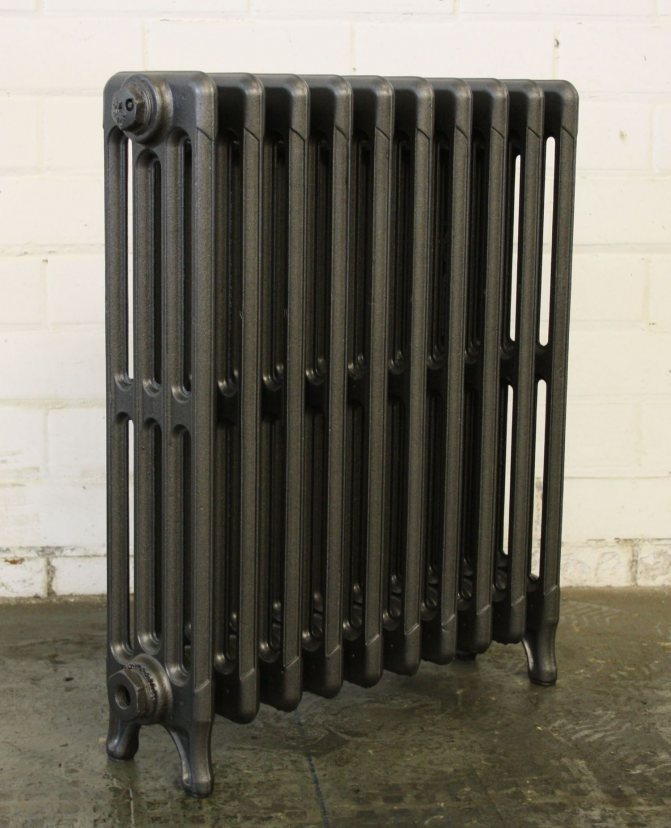
They have certain features and characteristics:
- Cast iron models. They are distinguished by a large mass, an increased coefficient of thermal efficiency. The massiveness of the structures dictates its own conditions - the models are made in compact sizes and no more than 1.5 m in height. Difficulties in metal processing and in the installation of a finished product are disadvantages, therefore cast iron for vertical radiators is rarely used. At the same time, the material is not picky about the purity of the coolant; mechanical inclusions are permissible in the water.
- Bimetallic products. These are batteries with a body made of aluminum and a steel core. The combination of metals results in strong and robust models that are resistant to wear and tear and with increased thermal efficiency.The metal case can be painted in different colors without compromising the practical qualities of the device. The downside is the high price.
- Steel appliances are highly durable, but at the same time have low heat transfer. The downside is the instability to corrosion, but there is also a plus - sections of steel vertical batteries are most often in the form of plates, so the price is lower than that of tubular options, and the aesthetic appeal is higher.
- Aluminum products provide high thermal conductivity, air heating efficiency, light weight and variety of battery designs. The minus is the rapid cooling of the models, moreover, such a radiator cannot be installed in systems with high working pressure, therefore, an aluminum vertical wall radiator is rarely found in apartments.
On a note! Batteries in vertical design, according to the type of material, are selected only for heating mains with an increased working pressure, which is maintained in multi-storey buildings and in production. For apartments, the parameter must exceed 7 bar.
Types by design
Considering high and narrow heating radiators, the owner must understand that the larger the surface area of the battery, the higher the efficiency of the device.
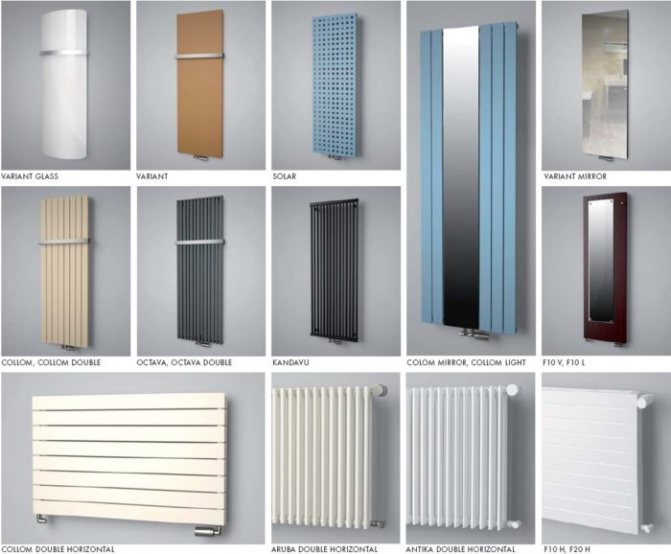

There are panel, sectional and tubular product shapes:
- Tubular models look like sections of tubes, connected at the top and bottom by manifolds. Most often, steel tubular batteries with welded elements are found on sale.
- Sectional units look like assembled elements with a flat front surface. They are mainly made of aluminum or two metals (bimetallic). The small area of contact is leveled by the high thermal efficiency of the material. Sectional batteries are more expensive and work on the convection principle. Prefabricated models make it possible to add or remove sections, depending on the wishes of the owner.
- Panel products are not collapsible, the front part is a sheet of metal or glass. Products with a mirror panel are more expensive.
Important! When installing products in private houses, the shape does not really matter, because all the heat remains inside the premises. The choice depends only on the aesthetic preferences of the owner and the purity of the coolant circulating through the pipes.
Types by type of heat source
In centralized heating systems and in most autonomous heating systems, water is used as a heat carrier, therefore, wall-mounted vertical water radiators are in high demand. But there are devices that run on electricity. Structurally, they look like standard water batteries, but instead of water, oil circulates inside.
The advantage of batteries is autonomy - they are connected to a power outlet and do not require piping. However, their use as the main heat source is ineffective due to the high cost of the energy carrier, but it is convenient to install such radiators for an auxiliary heat source. Electrical appliances are complemented by thermostats that control temperature indicators and turn on / off the system when the required heating or cooling parameters are reached.
What is better to choose radiators and batteries for heating an apartment
Features of mounting high radiators
Installing a vertical view of radiators differs little from installing a conventional battery. They can also be used with underwater pipes made of steel, polypropylene or polyethylene. But still, there are small subtleties of the installation. Since the coolant has a large area, and hence its mass, it must be fixed only on a main wall that can withstand a large weight of the product. In addition, when choosing a radiator with top piping, it should be borne in mind that the pipe will run along the entire height of the battery and spoil the overall aesthetics of the room with its appearance.
You can choose and buy vertical radiators for heating in the Dom-Termo online store. You will be surprised by the variety of models and their affordable cost.
Advantages and disadvantages of vertical heating radiators
Experts highlight both positive and negative aspects of these heat sources. Positive qualities include the following criteria:
Aesthetic and sophisticated look. They fit perfectly into any design direction, from classics to minimalism.
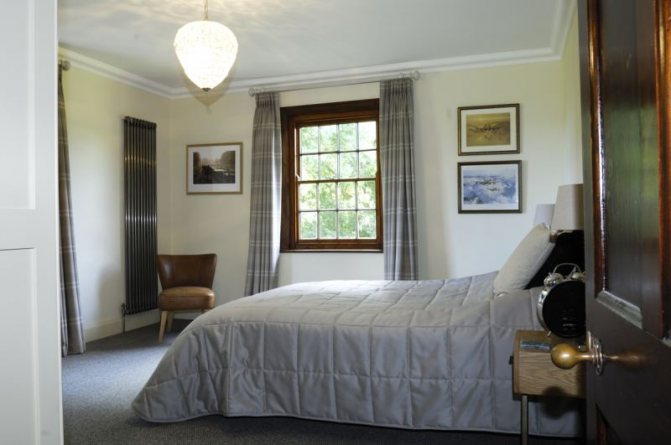

High performance. On average, this type of heating system can last more than 15 years.
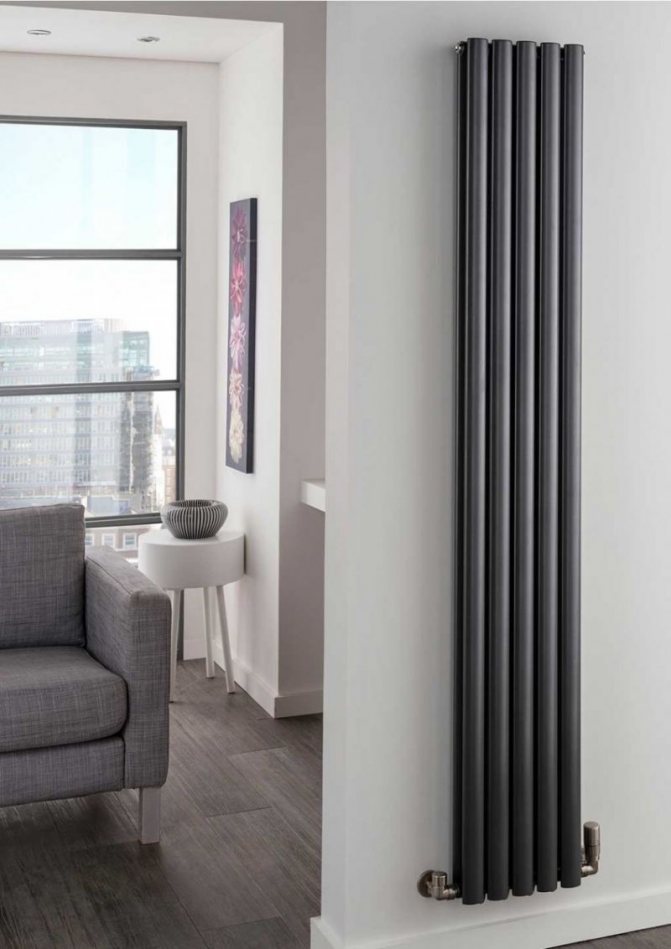

Easy installation. The connection of vertical heating radiators can be done independently. To do this, it is enough to connect the fittings to a central or autonomous heating system.

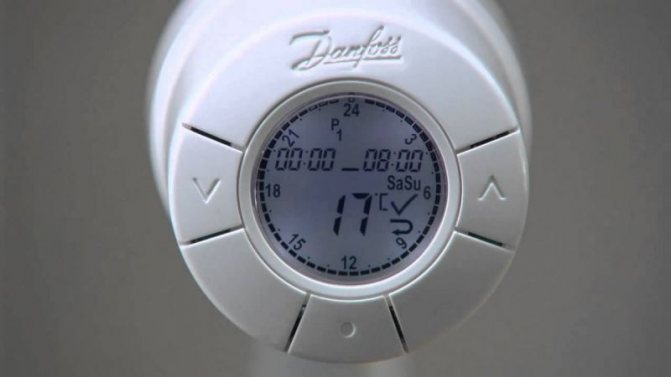
Thermostat for a heating radiator: purpose, types, device, installation in the system and tips for care and repair (video + 105 photos)
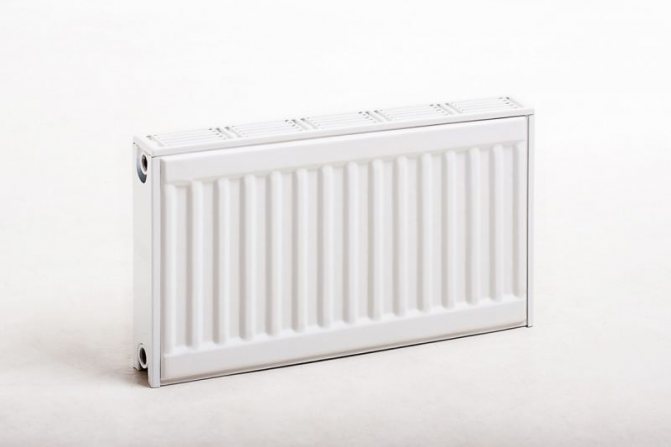
Heating radiator power: calculation of thermal power and method for calculating heating radiators (85 photos and videos)

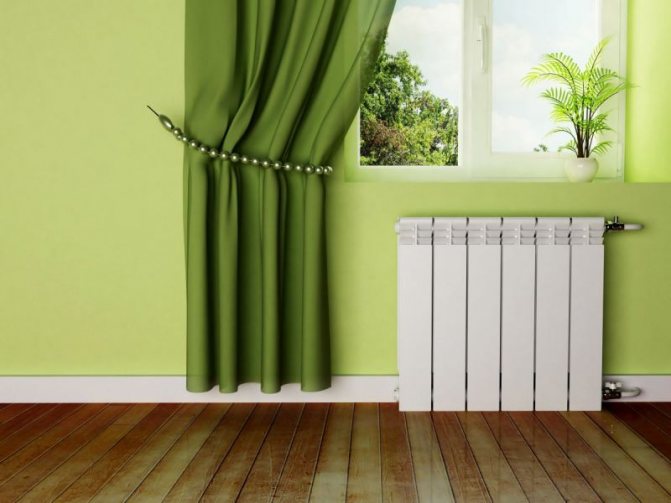
Heating radiator piping - connection diagrams and options for choosing a connection method (drawings + 90 photos)
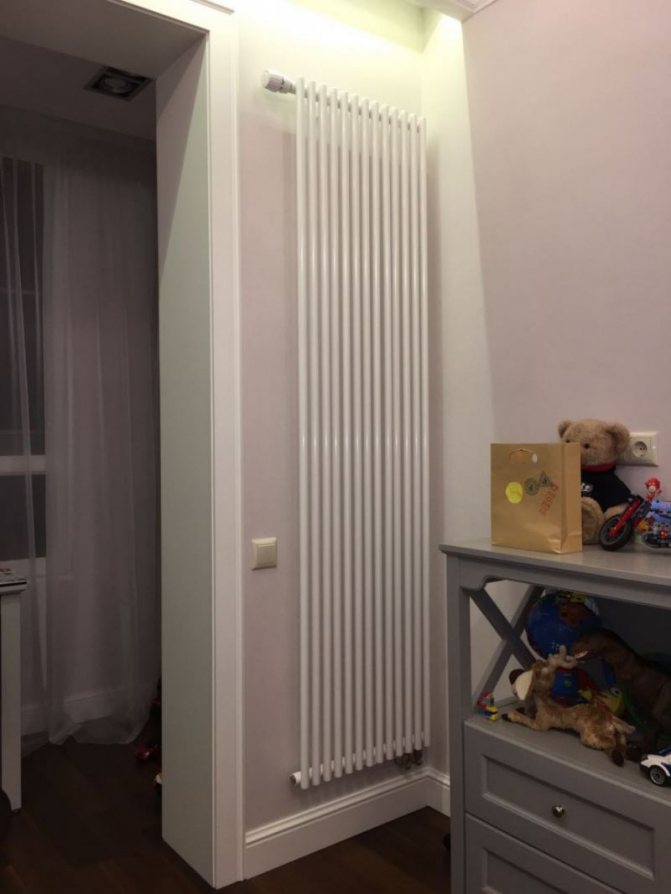

The joints must be carefully sealed. This will prevent leaks during operation.
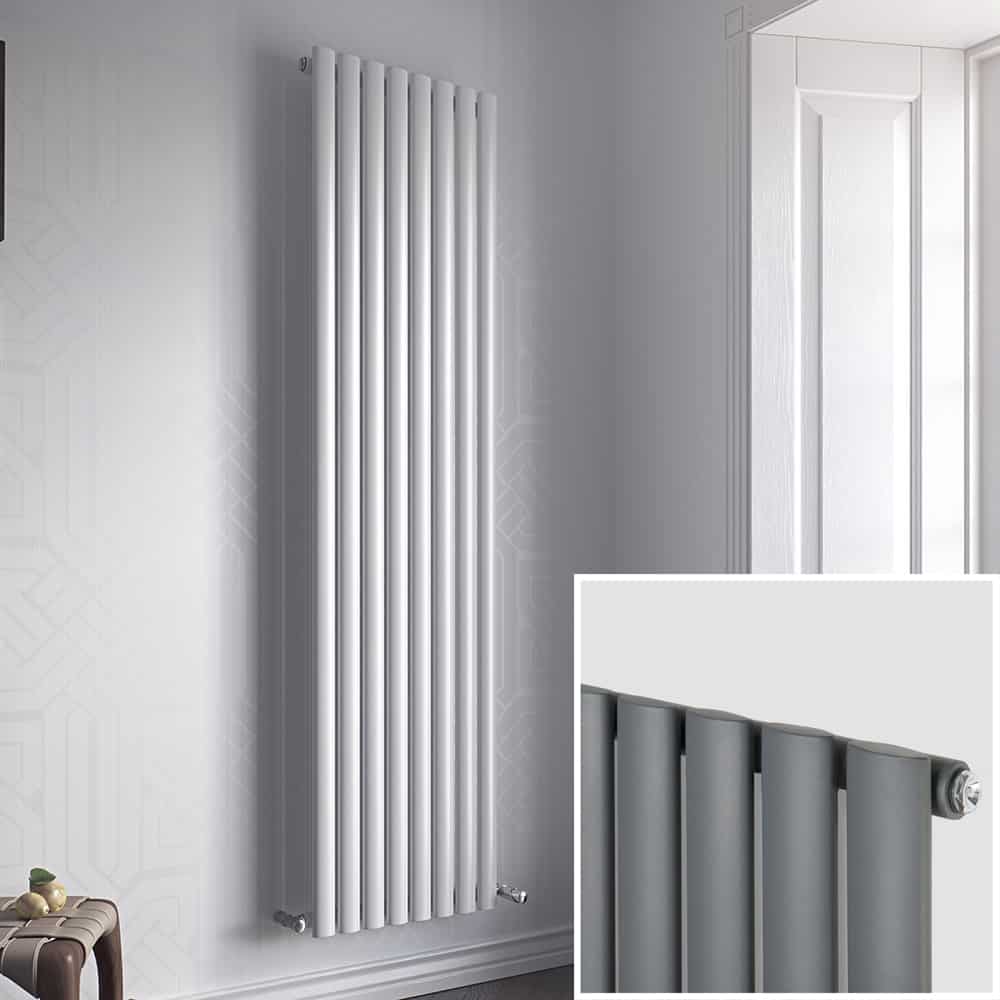

The possibility of modernization. Modern models of vertical radiators with bottom connections can be upgraded. Before that, it is enough to unscrew the side sections.
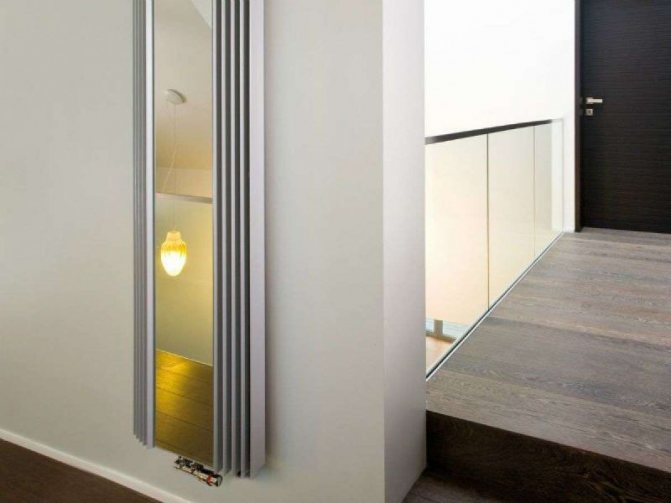

The disadvantages include:
Panel types of structures do not have a collapsible mechanism. They represent a monolithic structure that is fixed to the wall.
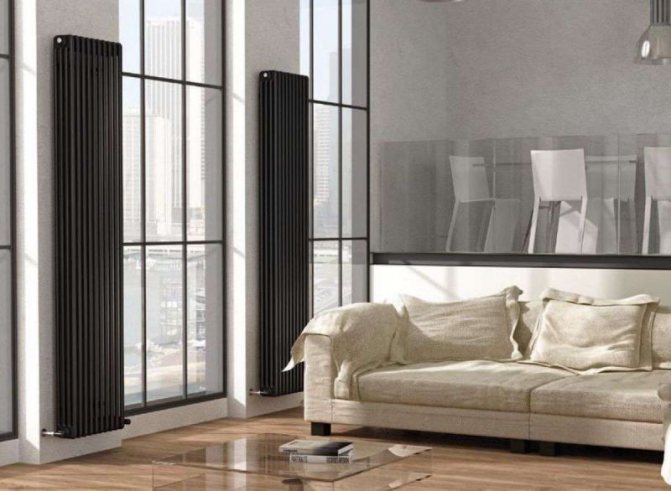

Requires constant maintenance. In some models, excess air constantly accumulates, which causes voids to appear. Indoor air is poorly heated. The photo of vertical heating radiators shows modern equipment models.
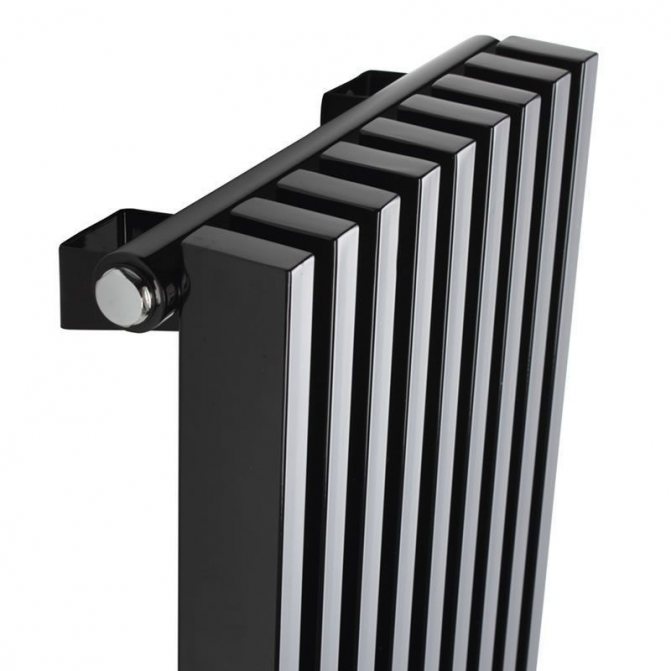


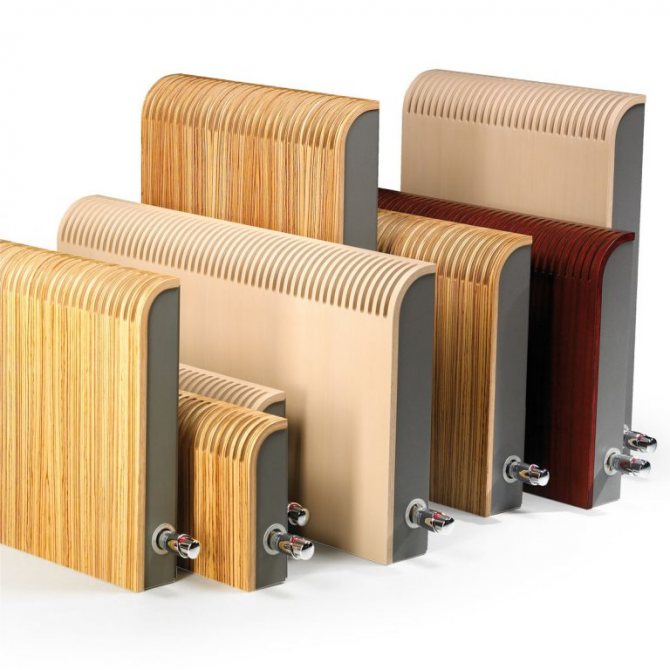
Water heating convectors: pros, cons and types of convectors. Expert advice on the selection and use of water convectors (135 photos and videos)
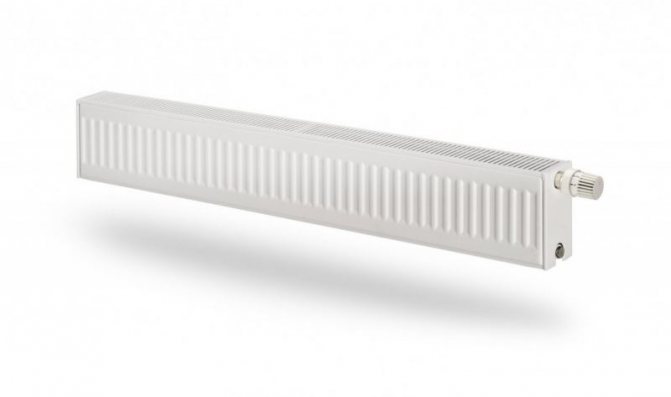
Which heating radiators are better: an overview of the best models for an apartment and a private house (115 photos)

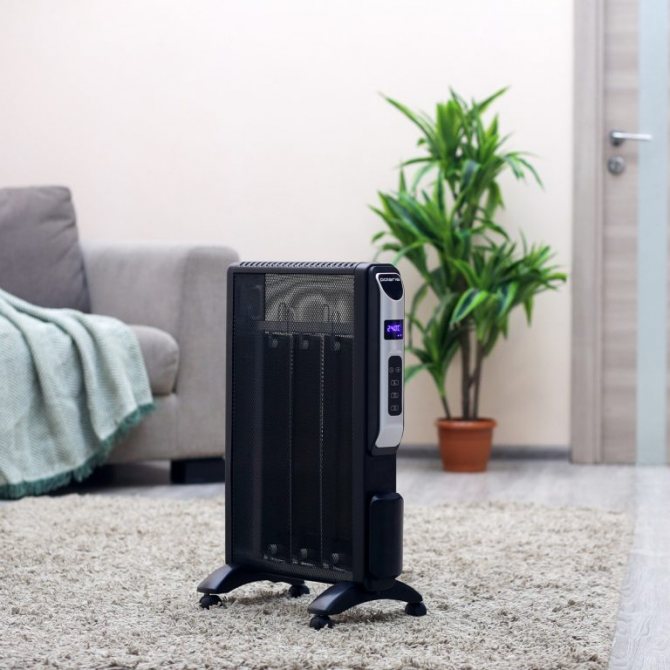
Micathermic heater - the principle of operation and rating of the best models of 2020 (140 photos and videos)
Types of radiators
The most popular types of radiators.
Cast iron. The most popular and widespread, and all due to the fact that they have a very high thermal conductivity, excellent chemical resistance and susceptibility to various carriers. They are completely unpretentious to the quality and manufacturer of the carrier, they have a simple and uncommon design. They are very reliable and durable in their use and service. They have a relatively low price compared to other types. On the market and in online stores, you can find a wide variety of variations in the design of cast iron radiators, which are suitable for both elite and chic premises, as well as for simpler and more ordinary ones.
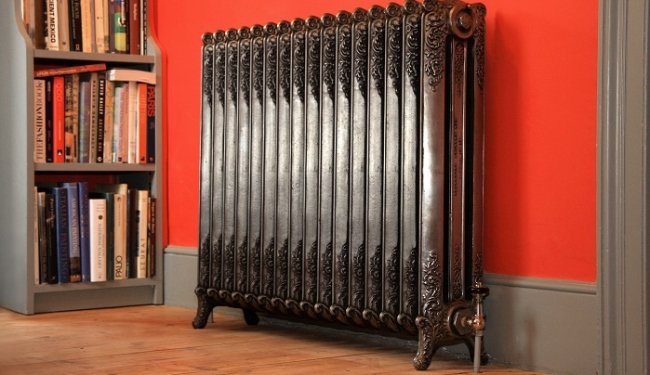

The figure shows a cast iron radiator.
Aluminum. Radiators of this kind have a high thermal conductivity, but their peculiarity is that they are best bought for private houses, since in multi-apartment buildings there is a different supply of water, which may have an unsuitable chemical composition. When buying a kit, you need to take automatic valves, which will help to avoid air formations that reduce heat supply. The main indicators of aluminum radiators are a beautiful and neat appearance that suits any design, excellent pricing policy and long service life.
Steel. This type of radiator has the same performance as the first.It has excellent thermal conductivity, beautiful appearance. They can be divided into tubular, panel and sectional batteries. The choice depends on personal beliefs and taste preferences. It is best to buy them for private houses, since steel radiators are very whimsical in their work.
Bitmetallic. This type of radiator is gaining more and more popularity and demand, as it combines all the positive qualities of aluminum and steel radiators.
Steel tubular heating radiators
If we consider steel heating radiators in more detail, then such positive aspects can be distinguished.
Any steel tubular heating radiators can withstand large pressure drops, which is very beneficial and convenient for multi-storey buildings, where the supply can be uneven and inadequate. This type of battery consists of an upper and a lower collector, which, in turn, are connected by steel pipes. They do not imply sharp edges, which makes them easy to repair.
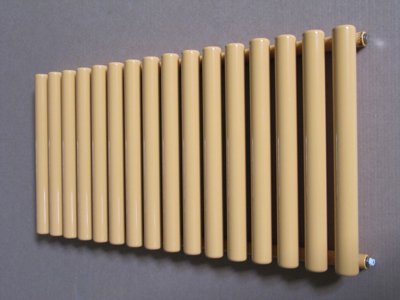

Steel heater.
Steel tubular radiators also have a huge color and design variety, as well as many shapes, which allows you to choose the best and most profitable radiator for any interior and room design. This type of radiator is the most hygienic and safe for both children and adults, and all due to the fact that it has no sharp corners. This makes it possible to easily and quickly remove and wipe it from dust and other types of pollution.
So that steel tubular radiators do not deteriorate not only from the outside, but also from the inside, they are covered with a special polymer composition, which significantly increases the service life.
An integral and significant plus is the ability to connect this type of radiator both from the side and from below, which is very beneficial for installation, because installation and connection does not require large costs and efforts.
The photo shows how such batteries look. But, as you know, where there are pluses, there are minuses. In steel tubular radiators, they are like that.
Among all heating radiators, it is steel that has the lowest power and heat transfer, which reduces the heating of the room.
In places where they are attached using spot welding, leaks and holes appear over time, which must be patched. Most often, after some time, they require immediate replacement, which will entail significant financial losses.
Equally important is the fact that most of the models in this category do not have an internal coating, which leads to a short service life.
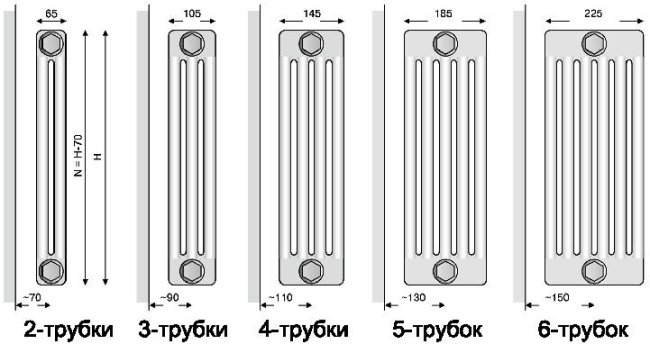

Steel radiator with different number of pipes.
Vertical tubular batteries
Vertical radiators are the same ordinary radiators, only their height is much larger than their length. The main positive characteristics of vertical tall tubular radiators.
A huge assortment, which consists in a large range of colors and in varieties of shapes, that is, this kind of heating batteries can be not only round, but wavy, curved, as well as any other variation. This depends on the personal preference of the customer.
Compactness and practicality, which allows the radiator to be placed on the wall, thereby leaving room for more important design elements. They are very practical when it is necessary to preserve some interior items that are afraid of heat and high temperatures by placing vertical tubular heating radiators in an advantageous position.
Ease and simplicity of installation, due to the simple design of the radiator itself. To install it, you will need to have only minimal skills, as well as a diagram or step-by-step instructions.
Wall mountable.After all, there is not always a place under the window or somewhere else at the bottom of the wall. The way out is very simple - mounting a vertical tubular radiator on the wall in any position. This can still emphasize the entire look of the room, or give it a more sophisticated look, and it will not strain it either.
A large heat exchange area, which guarantees a large heat transfer in any case and at any power, even if the vertical radiator is installed under the ceiling itself, this guarantees a constant heat supply that will be regular and reliable.
It will be interesting to see a photo of such batteries.
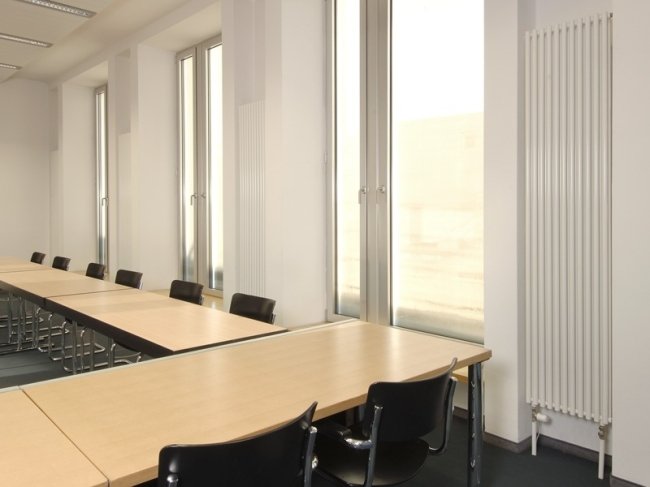

Vertical type of radiators.
As for the disadvantages and disadvantages of vertical tubular radiators, they most often arise from their parameters.
A high vertical radiator will have an order of magnitude lower heat transfer than a horizontal one, and this is due to the fact that it is located under the very ceiling or in the middle of the wall, where warm air is collected and concentrated. A vertical radiator gives off much less heat, which in general reduces heat transfer relative to the entire radiator, since the upper part of the tubes with less heat will also cool the lower part. Such work can entail a much shorter service life, since constant drops do not bring a positive effect.
Due to the fact that vertical high tubular heating radiators have such a shape and design, they are an order of magnitude lower than horizontal radiators.
Most of the heat will still concentrate under the ceiling, which is not very profitable and correct, therefore, even if you bought a vertical radiator, it is better to immediately install it in a horizontal position.
If we talk about the pricing policy of all the above-described radiators, then the most expensive are bit-metal, and the most affordable and cheapest are cast-iron or aluminum. You can buy any of these radiators in a specialized store or online store, where the price will, of course, be an order of magnitude lower.
Design features of tubular batteries
By their design, tubular batteries are a bit like cast iron ones. You can read more about cast iron heating radiators here. Only in appearance they are thinner and much more elegant. Such equipment consists of lower and upper collectors connected by steel pipes. The elements are connected using universal laser welding. Thanks to this, the seam is neat, it is almost invisible.
All tubular steel radiators are very robust. Due to the variety of sizes, shapes, colors, such a heater will fit into any interior of the apartment.
Where can tubular radiators be installed?
Steel tubular radiators, as a rule, are installed in private houses or in apartments of five-story buildings.
For urban high-rise buildings, a steel tubular radiator is not suitable.
Since water hammer often occurs in the central heating network. And the working pressure of the steel tubular battery is only 6-10 atmospheres. In the event of serious pressure surges, no specialist can guarantee the tightness and safety of the installation. In private houses, the working pressure is in the range from 6 to 8 atmospheres. Even if a water hammer occurs, the steel device will withstand such a load.
Steel tubular heating radiators are often used in medical institutions. This is because the batteries have excellent hygienic properties and are not traumatic. The device is characterized by the absence of corners, smooth curves. Dust does not accumulate on such radiators. And their wear resistance is much higher than that of their cast iron counterparts.
Characteristics of tubular steel batteries
Tubular heating radiators are most often made of steel. Steel tubular heating radiators are very popular, because steel is a strong and reliable metal.
The main technical parameters of steel tubular radiators are:
- Height. It is in the range of 30-300 cm.
- The number of tubes is not limited. There are single tube options. And there are many more.
- The depth is about 22.5 cm. There can be from 1 to 6 elements in a row in depth. For steel tubular radiators, the price depends on the working volume and parameters of the tubes.
- Sectional distance. It is presented in two versions: 6.5 and 4.5 cm. Batteries with a pitch between sections of 6.5 cm are most often used in hospitals, schools and other institutions where the requirements for the absence of pollution and dust are very high.
- The wall thickness varies from 0.1 to 0.2 cm. For imported models, the standard thickness is 0.1-0.15 cm. For domestic counterparts, this parameter is slightly larger - 0.2 cm.
- In the classic version, the section is round. The diameter is about 2.5 cm. True, pipes with flat, rectangular, oval and triangular sections are also found on sale.
Varieties of tubular batteries
Depending on the location of the tubes, the equipment can be of two types: horizontal and vertical. Horizontal ones are more often used in spacious office premises. But vertical tubular heating radiators are actively installed in private homes, hospitals and schools. Thanks to their design features, vertical models visually raise the ceiling and do not accumulate dust.
Depending on the shape, the heating device can be angular, flat, radius and design. The corner model assumes the division of the radiator into two sections, which are located at an angle in relation to each other. You can choose any angle. In the flat version, the tubes are arranged in one row. This is the most requested form among buyers. The radial device is in the form of an arc. Quite an interesting solution. This designer type heater is particularly original. Vertical pipes can be bent to create a wave-like structure.
Important parameters of heating equipment
Tubular heating radiators are most often produced in a vertical design. This decision is based on practical experience. The vertical pipes do not contribute to clogging and the formation of calcium deposits inside the heating equipment.
The equipment is available in different sizes, but there are standards:
- In height up to 300 cm. The highest tubular radiators are needed in duplexes, recreation, staircases and foyers on 2 floors. Narrow panels are installed not only in living rooms and bedrooms on both sides of the balcony doors, but also as a heated towel rail in bathrooms and mini-pools.
- Depths vary from 40 to 225 mm, however, in designer models or custom made, the parameters can vary greatly.
- The length of the tubular sections, on average, is 35-45 mm, but much depends on the heat output. Batteries with an impressive internal volume are designed to heat large rooms.
- The thickness of the steel tubes varies from 1 to 2 mm.
- The working pressure inside the tubular radiators is designed for a maximum of 15 atmospheres (this is quite enough). But there are also more resistant thick-walled radiators.
- The coolant temperature in the circuit is a maximum of 130 ° C (if it is antifreeze).

